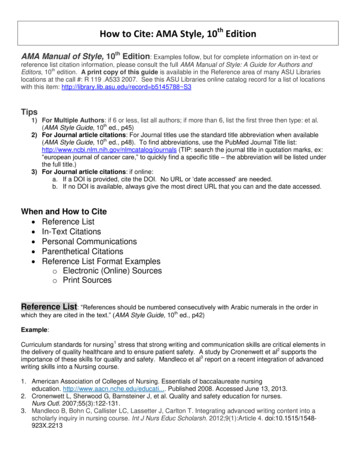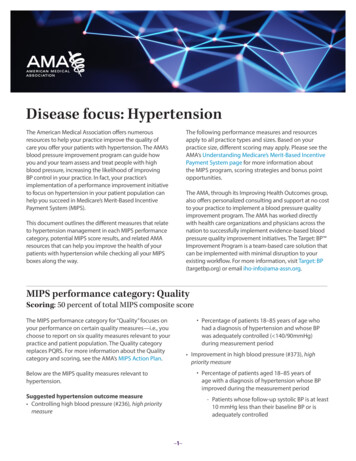
Transcription
Response to the 2016 AMA Report on LED LightingJune 30, 2016In response to the American Medical Association (AMA) report “Human and Environmental Effects ofLight Emitting Diode (LED) Community Lighting,” Mark S. Rea, PhD and Mariana G. Figueiro, PhD ofthe Lighting Research Center at Rensselaer Polytechnic Institute have prepared the below, which islimited to the effects of indium gallium nitride (In‐Ga‐N) LED lighting on humans.Recently the AMA has produced a document cautioning the public about In‐Ga‐N based LEDs usedas sources of illumination both indoors and outdoors. These In‐Ga‐N LED sources generate shortwavelength radiation from a solid state die. Some of that radiation is absorbed by a phosphor that,in turn, reemits long wavelength radiation. Together, the light emitted by the die and the lightreemitted by the phosphor appear white to the human eye. Depending upon the relative emissionsfrom the LED package, both the die and the phosphor, the white illumination can appear to have a“warm” tint (yellowish‐white) or “cool” tint (bluish‐white) or can appear neutral.This solid state lighting technology has, or soon will, displace most other commercially availablelight sources used for general illumination because they are more energy efficient, have longer lifeand are more cost effective to own and operate than most other sources of illumination. Theconcern expressed by the AMA in their report is focused specifically on the short‐wavelengthemission from these In‐Ga‐N LED sources as that spectral region might negatively affect, throughseveral modes, human health. Specifically, the following modes are of interest: Blue light hazard Glare, both disability and discomfort Melatonin suppression Circadian disruptionTo understand the potential risk to human health through each of these modes it is first necessaryto characterize the stimulus in terms of its physical properties and then second to relate thosestimulus properties to specific, measureable biological outcomes.1
Physical stimulus characteristicsAny light stimulus can be analyzed into the following physical characteristics. Spectrum Amount Duration Spatial distribution Timing PolarizationBiological response characteristicsBiological responses to light will mirror the physical stimulus conditions. Collectively, the spectral,temporal and absolute sensitivities of the biological system determine exposure. Hysteresis shouldalso be considered due to non‐linear changes in the biological system following exposure.Exposure:Spectral sensitivityTemporal integrationAbsolute thresholdHysteresisWhat must be known to make predictionsTo meaningfully discuss the consequences of light exposure on human biology, and therefore,health, all of the physical characteristics of light as well as the specific biological response to lightmust be known. For example, the human retina will not respond to very short‐ (UV) and very long‐(IR) wavelength optical radiation, so optical radiation emitted by sources in those regions will haveno impact on visual and non‐visual neural systems emanating from the retina. Light incident on theretina between the UV and IR bands can obviously evoke both visual and non‐visual systemresponses by the retina, but each of these systems is tuned to different, relatively narrowwavelength bands. Meaningful discussion of the impact of light on human health as affected byoptical radiation incident on the retina must therefore be framed in terms of the spectral emissionof the light source and whether the spectral sensitivity of the visual or non‐visual system is tuned tothat emission. The amount and duration of light exposure must also be defined. The spectralemission from a light source might be perfectly tuned to the spectral sensitivity of the biologicalsystem, but if the amount and/or duration of light exposure are too low and/or too short, there willbe no biological system responses. The timing of exposure is also important. For example, mostbiological responses to optical radiation, from humans to fungi, are dependent upon time of day.The same light stimulus may produce one effect at one time of day and a different response atanother time. Finally, since biological systems are non‐linear in their responses, the impact of agiven light exposure can be different depending upon previous light exposure conditions. As acommon example, melanin in the skin becomes darker with exposure to UV, thereby affecting the2
sensitivity of the system to subsequent radiation. Both sensitization and habituation are exhibitedby the biological system. Finally, the spatial distribution of light is fundamentally importantbecause all biological materials have optical properties that affect exposure. The cornea and thelens, for example, refract light to bring images to focus on the retina. Although polarization isanother important physical characterization of light, it has, unlike insects, a very small effect onhuman biology.1, 2Summary: Predictions of health consequences from light exposure depend upon an accuratecharacterization of the physical stimulus as well as the biological response to that stimulus.Without fully defining both the stimulus and the response, nothing meaningful can be statedabout the health effects of any light source.Biological Response CharacteristicsBlue light hazardHigh radiance, short‐wavelength light focused on the retina by the optics of the eye for an extendedduration has the potential to cause permanent damage to the retina.3, 4 Diffuse short‐wavelengthlight, as with the blue sky, does not cause damage nor do brief exposures to high radiance sources,as with incandescent filaments in a clear bulb. The American Conference of Governmental andIndustrial Hygienists (ACGIH) provide specifications for exposure limits for blue light hazard.5To determine risk, the radiance of the light source (not the irradiance from the light source), thespectral distribution, and the duration of focused exposure on the retina must be known. Unless allof those terms are specified, it is not possible to assess blue light hazard.Practically, however, the LED package (die phosphor) can have high radiance in a spectral regionthat can cause damage. So, by calculation, focused, steady viewing of a 500 mW LED package ( 5W/cm2/sr) for approximately 10 seconds can cause damage. Humans’ natural photophobicresponse to bright light would likely limit focused exposure to much less than a few seconds;however, some individuals may not have the capacity to avert gaze, such as premature infants.Summary: Notwithstanding certain sub‐populations that deserve special attention, blue lighthazard from In‐Ga‐N LEDs is probably not a concern to the majority of the population in mostlighting applications due to human’s natural photophobic response.3‐11Disability and discomfort glareThere are two types of glare, one that can impair visual performance, disability glare, and one thatcauses an unpleasant sensation, discomfort glare. To determine the magnitudes of disability anddiscomfort glare, different formulations are necessary. Disability glare depends upon the amount ofscattered light from small particles in the eye, but these particles are large enough that scatter isindependent of wavelength. Therefore, short‐wavelength and long‐wavelength light produce thesame amount of entopic scatter. Where visual performance (e.g., reading or judging speed anddirection of a moving automobile) is important, the deleterious effects of scattered light can beweighted by the conventional photopic luminous efficiency function [V( )]. The well‐establishedFry (1954) disability glare formulation can be used to assess the impact of the light source in termsof conventional, photopic illuminance at the cornea and the angular distance between the line ofsight and the light source.12 Therefore, assessing the impact of In‐Ga‐N LED sources on disability3
glare would be the same as it would be for any other commercially available light source that mightbe used indoors or outdoors.Discomfort glare is, however, much more complicated to assess. Like disability glare, discomfortglare increases with irradiance at the cornea and with reductions in the angular distance betweenthe light source and the line of sight. Unlike disability glare, however, the spectral composition ofthe light source also influences discomfort glare; sources with relative greater short‐wavelengthcontent are seen as producing more discomfort for equal photopic illuminance at the cornea. Allother factors being constant, sources dominated by short‐wavelengths will produce relatively morediscomfort glare than sources dominated by long‐wavelengths. For white light sources, this effect isrelatively small, relative to changes in corneal irradiance. The apparent size of the luminouselement itself also impacts discomfort glare. Again, all other factors being constant, luminouselements larger than about 0.3 degrees of visual angle will produce more discomfort glare thansmaller luminous elements. For light sources viewed from a short distance where the luminouselement is 0.3 degrees of visual angle or larger, the discomfort‐glare‐specific spectrally weightedradiance of the light source must also be known to predict discomfort glare.13Summary: In‐Ga‐N LED sources dominated by short wavelengths can cause relatively greaterdiscomfort than sources dominated by long wavelengths, including “warm” In‐Ga‐N LEDsources, at the same photopic illuminance at the cornea. As with disability glare, however,discomfort glare is mostly determined by the amount and distribution of light entering theeye, not its spectral content.12‐14Melatonin suppressionMelatonin is a hormone that signals “darkness” to the body; it is produced at night and in darkness.Retinal exposure to light during the nighttime can suppress melatonin synthesis by the pineal glandin the brain, potentially disrupting physiological processes timed to occur at night. “Darkness” is arelative term, however. Humans have a high threshold to retinal light exposure for suppressingmelatonin at night.15, 16 Well below this threshold (approximately 30 lux at the cornea from whitelight for 30 minutes), both rods and cones in the retina provide adequate visual information tohumans for navigation, social interactions and even reading printed materials.17 Nevertheless, thespectral sensitivity of melatonin suppression is dominated by short wavelengths,18‐24 soconventional means of measuring light exposure based upon the photopic luminous efficiencyfunction (i.e., for visual performance) can underestimate the potential impact of In‐Ga‐N LEDsources for suppressing melatonin at night. Light sources used for domestic and roadway lightinghave traditionally been sources dominated by long‐wavelengths, so the impact of In‐Ga‐N LEDsources on melatonin suppression could, in principle, be of concern. New photometric instrumentsalong with insights into the mechanisms underlying phototransduction by the retina as it affectsmelatonin suppression have been developed.20, 25 Thus, it is now possible to measure and toquantify the impact of light exposure from any spectral irradiance distribution on nocturnalmelatonin suppression in humans. These developments have, for example, provided insight intothe impact of self‐luminous displays on nocturnal melatonin suppression. 26‐28It should be noted that melatonin appears to have an oncostatic effect on cancer proliferation.Blask and colleagues have shown that melatonin limits tumor progression in nocturnal rodents.29, 30The amount and the spectrum of light as they affect nocturnal rodents are quite different than theyare for humans, however. Mice are between 3000 to 10000 times more sensitive to light as it4
affects melatonin synthesis at night.31 Therefore, care must be given to any extrapolations fromstudies of melatonin suppression in nocturnal rodents to those in humans, particularly with regardto both visual and circadian phototransduction.Summary: In‐Ga‐N LED sources dominated by short wavelengths have greater potential forsuppressing the hormone melatonin at night than sodium‐based sources commonly usedoutdoors. However, the amount and the duration of exposure need to be specified before itcan be stated that In‐Ga‐N LED sources affect melatonin suppression at night.Circadian disruptionPhysiology and behavior of all vertebrates on Earth, including humans, are regulated by the 24‐hour light‐dark cycle incident on the retina. Disruption of that natural rhythm, either by rapid travelacross time zones, or by aperiodic or highly variable exposures to light and dark at the wrong time,can cause disruption of physiology and behavior.32‐38 Epidemiological evidence suggests thathumans performing rotating shift work are subject to a wide range of serious maladies from breastcancer to cardiovascular disease.39‐45 Melatonin suppression at night is undoubtedly an importantpart of circadian disruption, but it is not synonymous with circadian disruption. Staying awake indim light at night or limited exposure to light during the day can also be disruptive to physiologyand behavior, even though there is no effect of the light on melatonin concentrations. Thesedisruptive social‐behavioral effects may or may not be associated with nocturnal melatoninsuppression.46‐49Much less is known about the spectral and absolute sensitivities to light as they affect circadiandisruption. However, limited studies with red light exposures, which cannot suppress nocturnalmelatonin synthesis, have shown that circadian‐regulated physiology and behavior are affected.50, 51Again, therefore, it is quite possible that the negative impacts on human health by performingrotating shift work may only have a limited relationship to nocturnal melatonin suppression.Summary: Until more is known about the effects of long‐wavelength light exposure (amount,spectrum, duration) on circadian disruption, it is inappropriate to single out short‐wavelength radiatio
the Lighting Research Center at Rensselaer Polytechnic Institute have prepared the below, which is limited to the effects of indium gallium nitride (In‐Ga‐N) LED lighting on humans. Recently the AMA has produced a document cautioning the public about In‐Ga‐N based LEDs used as sources of illumination both indoors and outdoors. These In‐Ga‐N LED sources generate short











